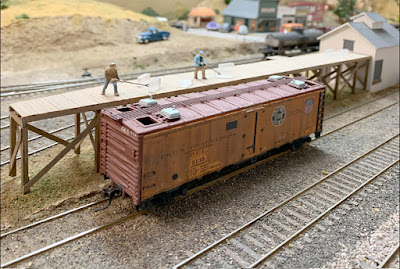My topic today is realistic operation of a layout, including small layouts, and how to achieve it. A goal of many layout owners, including me, is to offer a realistic operating session when guest operators visit. But what do we mean by “realistic?” That’s what I want to go into.
I won’t spend too much time describing what actual layout owners have done or are doing, but intend to indicate what I think is required. This is drawn in part from experience hosting about 100 operating sessions on my own layout, but is also based on my experience on dozens of other layouts, many of them that I have operated on multiple times.
So what’s the core idea? For me, the core of realistic operation is following the prototype. Okay, what does that mean? I divide it into three parts: the first is in some ways the most obvious to observe, and yet the least important of the three, and I’ll explain why. This first point is realistic appearance. (I’ll return to the other two.)
There is an enormous amount of published material on this topic, and rightly so, because it has so many dimensions: scenery, trackwork, structures, rolling stock and locomotives, backdrops, on and on. And certainly this can matter, because just the first glimpse of a visually great layout is usually stunning. But I think it’s important to recognize two points: first, that a visually stunning layout may not actually be very prototypical (Malcolm Furlow’s dioramas come to mind), and second, that there have been and still are any number of freelanced (not prototype railroads) layouts that meet the realistic appearance standard.
But before continuing, I should mention that I realize my topic is awfully close to the title of Tony Koester’s Kalmbach soft-cover book (2nd edition, 2013), which I reviewed when it had recently come out (you can see that post at: https://modelingthesp.blogspot.com/2014/03/tony-koesters-recent-operations-book.html ). I hope to go beyond the basics of Tony’s fine book.
As I stated above, the first thing that comes to mind in trying to define “realistic appearance” is fidelity to the prototype. How broadly can we define this? I once visited a layout built by an owner who wanted to imagine a future time when hydrogen fuel would be used in locomotives (and in the rest of the economy), and had rolling stock, locomotives, and industries thoroughly “imagineered” to suit this vision. But I think there is a real barrier to “realism” in such an approach, just as there would be in a layout with brightly-colored rolling stock on a layout (named for the owner’s children) called the “Jimmy and Susie Railroad.”
But that shouldn’t be interpreted to mean that free-lance layouts have a problem, provided their appearance and operation are in fact “realistic.” There are famous examples, like Allen McClelland’s Virginian & Ohio, Bill Darnaby’s Maumee, Jim Providenza’s Santa Cruz Northern, Tony Koester’s former Allegheny Midland, and Jack Ozanich’s Atlantic Great Eastern, all beautifully executed layouts with strongly prototypical looks and operation. Below is a photo I took on the AGE. I think it speaks for itself.
Still, choosing a prototype railroad to model can furnish a strong connection to a visitor’s existing knowledge. This was, in part, the inspiration for my own present layout. During the year I lived in England, attending model railroad exhibitions on many weekends, I saw the strength of the idea behind many portable exhibition layouts: an imaginary branch line of a familiar railroad. Then the locomotives, depots, freight car appearance, signals, and so on, are all familiar sights, making many features of the model obviously prototypical.
With that inspiration, I chose to model a long-time favorite, the Southern Pacific, while also choosing to follow the imaginary branch line idea. That in turn means that I model a real railroad in a fictitious place. For me, however, it’s more important that the scenes modeled and the operations practices should reflect the prototype’s practices, than that places are accurately modeled.
A single example of this is my two-car ice deck, a common size in small towns, with its features and details taken from PFE prototype practice (as I described recently at: https://modelingthesp.blogspot.com/2024/06/background-for-my-layout-ice-deck.html ). Below is a photo of it in use.
And to repeat, lots of authors have discussed this same topic. A notable example, rarely recognized these days, is Frank Ellison, in a number of his articles and publications. Particularly rarely recognized is his article from the January 1956 issue of Model Railroader, entitled “Fitness of Things,” focusing on any number of physical features of outstanding layouts. You can click to enlarge it if you’d like to read this page.
Of course, the real way to represent a prototype railroad in full is to buckle down to the challenge of choosing scenes to model, artistically compressing them to retain the core of their appearance, and then getting it all built. Probably there exists no better example than Jack Burgess’s Yosemite Valley, a superbly conceived and beautifully modeled and detailed double-deck railroad (photo by Venita Lake).
But beyond realistic appearance, I believe, come two further points, which both relate to the way in which the layout is operated. This post has already gotten long, so I will defer comments on these operation aspects to future posts, and will address the two parts of following the prototype not covered here.
Tony Thompson




No comments:
Post a Comment